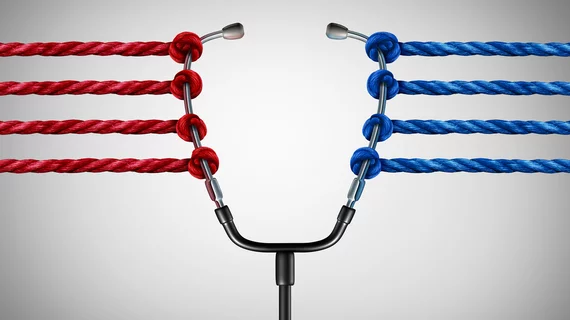Does radiology have a ‘woke’ problem? ‘Disturbing’ results show bias against conservative trainees
Does radiology (and medicine in general) have a problem with “wokeness?” It’s a question recently posed by a conservative-leaning publication after reviewing the “worrying” results from a new imaging study.
Researchers published the piece in the June issue of the American College of Radiology [1], exploring how bias might shape faculty decisions to select certain potential residents. North Carolina radiologist Charles M. Maxfield, MD, and co-authors conducted what they call a “discrete-choice experiment,” asking faculty across 30 U.S. radiology programs to choose between two made-up, “hypothetical” resident applicants.
Extracurricular activities exerted as large of an influence on resident selection as traditional academic and demographic attributes. For instance, conservative ideology appeared to disadvantage applicants, while faculty preferred individuals with progressive-leaning activities on their resumes.
“Although cultural similarities may identify applicants who are ‘a good fit’ and contribute to resident harmony within the program, cultural matching may have negative, unintended consequences,” Maxfield, vice chair of education in Duke University Medical Center’s Department of Radiology, and co-authors wrote. “Culture matching may introduce an affinity bias against applicants of different backgrounds who present a cultural conflict. This can promote an institutional monoculture and discourage diversity of thinking.”
The National Review seized on the results, publishing a response on Aug. 3 with the headline: “Are Young Republicans allowed to be radiologists?”
“To see where the woke set is going, look no further than a disturbing article published last month by a major medical journal,” wrote Ian Kingsbury, director of research at Do No Harm, a healthcare advocacy group that lobbies against gender-affirming care for minors, DEI initiatives and diversity training, among other causes. “It shows a frightening new level of discrimination by political ideology, in which those who deviate from liberal orthodoxy are punished for their views.”
A total of 240 participants completed the exercise, ranking community service most highly among hypothetical candidates. Meanwhile, participants demonstrated preference for trainees involved with the “LGBTQ Pride Alliance” (with an odds ratio of 1.56, signifying a higher likelihood they’d select such individuals). Conversely, respondents showed bias against candidates who identified as “Young Republicans,” with a much lower odds ratio of 0.60.
Religious bias also “reared its ugly head,” the National Review noted. Maxfield and colleagues identified certain “blue evaluators,” who preferred candidates volunteering for Sen. Elizabeth Warren, D-Mass., over those that identified as Young Republicans. Compared with other “red evaluators,” their blue counterparts rated candidates in bible study, involved in “Christians on Campus” and Young Republicans significantly lower.
“Politics and culture [extracurricular activities] correlated strongly with the presumed political leanings of the evaluator,” Maxfield and co-authors noted. “Characterization of political leanings is complex, including social, economic, historical and religious influences. Voting groups are rarely monolithic, but for this study using ‘volunteer, Elizabeth Warren for President’ and ‘Young Republicans’ as surrogates for political leaning, blue participants strongly preferred culturally progressive [extracurricular activities] (i.e., ‘LGBTQ Pride Alliance’) but penalized socially conservative EAs (i.e., “Christians on Campus”). Red participants’ treatment of politics and culture EAs was more mixed. The alignment of red participants with politically and socially conservative EAs was as expected, but red participants had positive associations with ‘LGBTQ Pride Alliance,’ a culturally progressive EA. No politics and culture EAs reached statistical significance among red participants.”
Maxfield et al. cautioned that this may reflect a lack of statistical power, since only 23% of participants were classified as red. This despite the broad demographic and geographic representation of the Radiology Residency Education Research Alliance, from which study participants were pulled.
The NR article had garnered nearly 200 comments less than two weeks after it was posted. Maxfield contends that the response should be taken seriously by residency program directors who value diversity. He believes the results of the study are a “big deal” in the context of losing certain objective performance metrics.
“Bias has always been an issue,” Maxfield told Radiology Business by email after the Review article was published. “Our decisions have always been influenced by our biases. What’s new is that we are losing the objective performance metrics that we’ve long trusted to select residents. For instance, Step 1 scores, class rank, grades and medical school honors. In that vacuum, our biases become more impactful, whether we realize it or not.”

